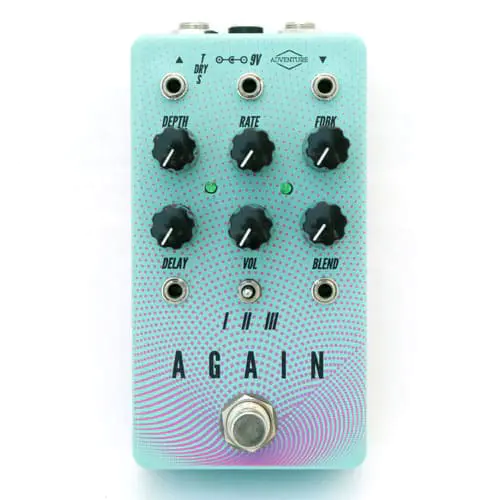
Upstate NY pedal builder Adventure Audio unveiled (and shot a video of) a fuzz at our 2019 Brooklyn Stompbox Exhibit, but, on their board, also had a prototype of another new pedal which is now ready and shipping: the Again Delay/Modulation.
The circuit itself is not as mind-bending as other Adventure Audio effects, but what makes this device stand apart from any other pedal out there is its ability to deeply integrate with modular synths (and the Eurorack format in particular) through the presence of five Control Voltage inputs:
[It’s a] classic vintage style, modulating delay […] with while adding the flexibility to control 5 parameters via control voltage jacks. […]
CV jack pairs function together. When a CV source is plugged into a jack, the respective knob acts as an offset control for the CV signal. I.E. a CV signal that moves between -1 volt and 1 volt can be made to move between say 4 volts and 6 volts if the position of the corresponding knob is set to 5 volts.
The Again is designed around a cascading system of three PT2399s, and can provide lo-fi slapback tones to long, tape-like repeats. The central toggle switch, which gives you different lengths for the delay.
Here are the videos of the Adventure Audio Again, we added it you our lists of the Best Tape-Style Pedals and the Best Pedals with CV In.
Again is the classic vintage style, modulating delay you’re already familiar with while adding the flexibility to control 5 parameters via control voltage jacks. Designed around a cascading system of 3 PT2399s, Again can provide lo-fi slapback tones to long, tape-like repeats.
I II III Toggle – There are three separate delay stages arranged in series and this toggle selects which one the output is taken from. Functionally it acts as a time range control for the delay time, I being the shortest and III being the longest.
DELAY – Sets the length of the delay. Turn counter clockwise for shorter delay and turn clockwise for longer delay. With the knob in the center position, the CV input range is -8 to 8 volts. When stepped CV signals are used (like the output from a sequencer or sample-and-hold) pitch shifting type effects can be achieved on the delayed signal.
FDBK – Controls the amount of feedback for the delay. When turned up all the way the delay will go into crunchy dirty self oscillation. The pitch and timbre of the oscillation can be manipulated with the other controls. CV input range is 0 to 8 volts.
BLEND – Controls the blend between the input signal and the delayed signal. CV input range is 0 to 8 volts. When the CV input is fed with an LFO a sort of tremolo effect can be achieved.
DEPTH – Controls the strength of the modulation signal. When turned fully counter clockwise, the modulation is effectively turned off (unless a CV signal is being used). CV input range is 0 to 8 volts.
RATE – Controls the speed of the modulation signal. Speed ranges from approximately 0.35 Hz to 14.5 Hz. CV input range is -8 to 8 volts.
Again contains a built in triangle LFO for modulation. The modulation signal is mixed with whatever CV signal is plugged into the DELAY CV jack (if there is one). The sum can then be offset with the DELAY knob.
All ?’ jacks are for control voltage (CV) inputs and correspond to the vertically adjacent knob.
All knobs – CV jack pairs function together. When a CV source is plugged into a jack, the respective knob acts as an offset control for the CV signal. I.E. a CV signal that moves between -1 volt and 1 volt can be made to move between say 4 volts and 6 volts if the position of the corresponding knob is set to 5 volts.
The output jack can be used with a standard TS cable, but can also be used with a TRS cable. If a TRS cable is used, the dry input signal is available on the ring connection and the pedals output is available on the tip connection. When used with a splitter jack or a splitter box and the BLEND turned all the way up the clean signal can be passed onto other effects and to one amp while the fully wet signal from Again can be sent to other effects and into a seperate amp for a dual dry/wet set up. Or the signals can be mixed back together after separate processing, you know, whatever you’re feeling.
The left LED represents the delay time. The longer the delay time, the brighter the LED gets.






















